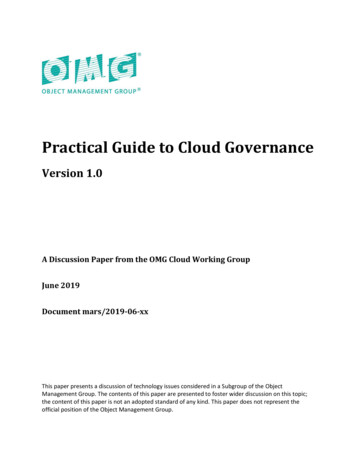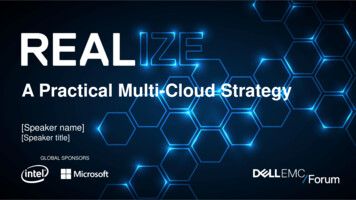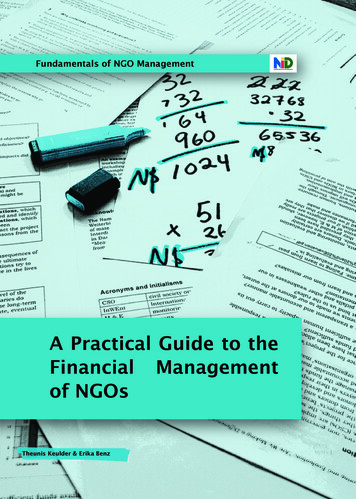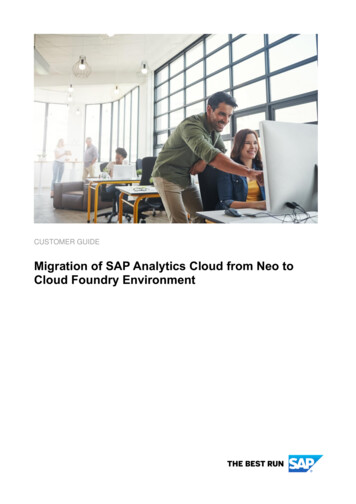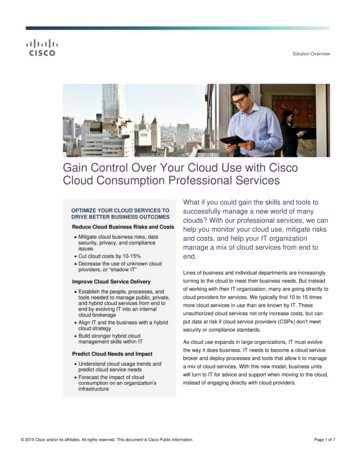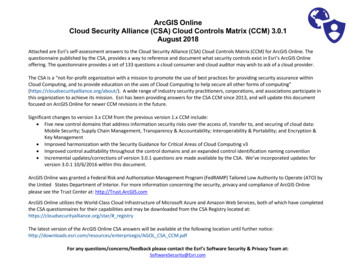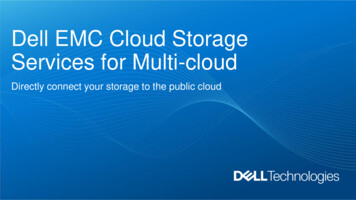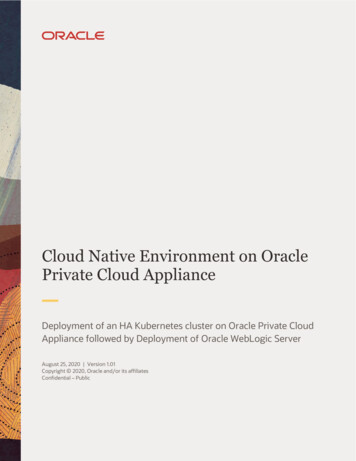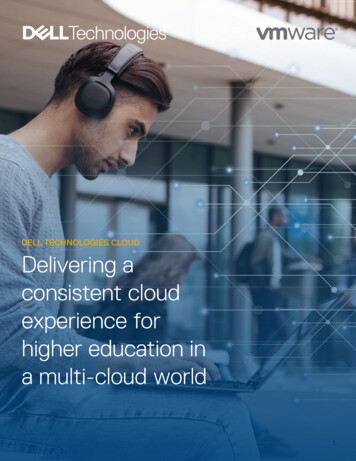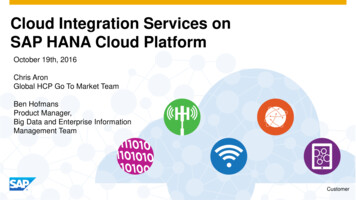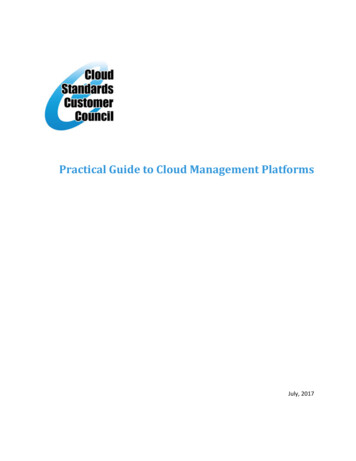
Transcription
Practical Guide to Cloud Management PlatformsJuly, 2017
ContentsAcknowledgements. 3Executive Overview . 4Defining Cloud Management Platforms and the Evolving CMP Market . 4Challenges of Hybrid Cloud Services . 5Functions of a Cloud Management Platform . 6The Cloud Management Platform Landscape. 10Evaluation Criteria When Selecting a Cloud Management Platform . 12Deployment Considerations . 16References . 17Copyright 2017 Cloud Standards Customer CouncilPage 2
2017 Cloud Standards Customer Council.All rights reserved. You may download, store, display on your computer, view, print, and link to thePractical Guide Cloud Management Platforms at the Cloud Standards Customer Council Web site subjectto the following: (a) the Guidance may be used solely for your personal, informational, non-commercialuse; (b) the Guidance may not be modified or altered in any way; (c) the Guidance may not beredistributed; and (d) the trademark, copyright or other notices may not be removed. You may quoteportions of the Guidance as permitted by the Fair Use provisions of the United States Copyright Act,provided that you attribute the portions to the Cloud Standards Customer Council Practical Guide toCloud Management Platforms (2017).AcknowledgementsThe major contributors to this whitepaper are: Mike Edwards (IBM), Preetam Gawade (nCryptedCloud),John Leung (Intel), Bill McDonald (WRM Consulting), Karolyn Schalk (IBM), Karl Scott (Satori Consulting),Bill Van Order (Lockheed Martin) and Steven Woodward (Cloud Perspectives).Copyright 2017 Cloud Standards Customer CouncilPage 3
Executive OverviewThe aim of this guide is to provide a practical reference to help enterprise Information Technology (IT)managers, business decision makers, system operations staffs, application architects and applicationdevelopers understand the functions of Cloud Management Platforms (CMPs) and how they can be usedto operate and manage applications and data across multiple cloud infrastructures including both onpremises and public cloud service providers. The paper also describes some of the commonly availableCMPs in the market to help assist customers in making a selection of a CMP best suited to their needs.While cloud brokerage and cloud management can be considered separate activities, the rise of hybridIT architectures increases the importance of process harmonization and tools interoperability to meetevolving requirements.Defining Cloud Management Platforms and the Evolving CMP MarketCMPs provide a means for a cloud service customer to manage the deployment and operation ofapplications and associated datasets across multiple cloud service infrastructures, including both onpremises cloud infrastructure and public cloud service provider infrastructure. In other words, CMPsprovide management capabilities for hybrid cloud environments.Gartner sets the minimum requirements for CMP offerings as: “ products that incorporate self-serviceinterfaces, provision system images, enable metering and billing, and provide for some degree ofworkload optimization through established policies.” [1] Given the rapid increase in adoption of hybridcloud environments these minimum requirements are a base level for CMP capabilities.IT analysts claim that the average enterprise uses some combination of five or six different cloudenvironments, typically a mix of private on-premises and public environments. [2] Hybrid cloudenvironments are expected to grow at a CAGR of 34.3% during the period of 2016-2022 to reach anaggregate of 241.13 billion by 2022. [3] Hybrid cloud adoption has expanded the role of IT operationsand created a demand for adaptable management tools capable of supporting the complexity of hybridcloud deployments. The market for CMPs can be expected to increase alongside the predicted growth inuse of hybrid cloud environments. The capabilities of CMP offerings are also expected to evolve to meetthe increased complexity of the target environments and more sophisticated requirements fromenterprise customers.To meet the most frequently mentioned drivers for adoption of hybrid cloud architectures – costoptimization, speed of innovation, and ‘future proofing’ – an enterprise CMP also needs to includespecific functionality and the capability to integrate easily with a range of other enterprise managementsystems, both inside and outside IT operations. The CMP cannot create another, standalone system inan increasingly complex operational space. Rather, the CMP needs to serve as an integration pointacross existing and new systems.The challenge of IT operations today is largely in the number of data points needed to gain visibility andthe variety of systems used to collect the data. A CMP needs to provide a simplified management viewCopyright 2017 Cloud Standards Customer CouncilPage 4
through its functionality and the aggregation and integration of data from the multiple cloudenvironments.Necessary functionality includes: Access and authorization managementResource management across environmentsFinancial management relating to subscribed cloud servicesIntegration with the relevant target cloud environments and enterprise internal systemsService catalogs to support self-service provisioning or resource approvalsCloud brokerage – rules-based guidance for asset placement decisionsIntegration points can include: Service delivery systems – part of self-service, approval and ongoing management ofdeployment and cloud service consumption.Identity and access management – leverage enterprise SSO and role-based permissions wherepossible.ERP and financial systems – collect metering information from the CMP for billing and invoicing,internal chargeback.Automation tools – automate deployment according to rule sets and manage resourceconfiguration.Infrastructure monitoring – visibility of operational data to support SLA management, securityalerts, threat monitoring.Business process rules systems or other business systems that include rules used for such thingsas governance of cloud consumption or self-service, approval flows, and billing.For mature enterprises the CMP could use, wherever possible, data, policies, and governance alreadydefined within systems or processes. For less mature or smaller organizations, configuration of the CMPcan guide them through the establishment of these policies and processes. For all organizations the CMPneeds to provide specific functions, such as usage metering, that are not part of ordinary enterprisefinancial or accounting packages.Challenges of Hybrid Cloud ServicesAdoption of hybrid cloud services is driven by the need to reduce cloud infrastructure spend, increasespeed of delivery, improve IT resiliency, more effectively service a variety of workloads (e.g., highperformance computing), use best-of-breed cloud services, and avoid vendor lock-in. There are manypotential benefits associated with the use of hybrid cloud services. However, hybrid cloud can introducenew challenges that IT should be prepared to address:Copyright 2017 Cloud Standards Customer CouncilPage 5
Governance – The use of hybrid cloud increases the challenge to effectively maintain visibility ofcloud resources, to manage spend (including chargebacks), and to ensure quality of service. Thelevel of complexity introduced by hybrid cloud adoption requires strong governance.Security and protection of PII and other sensitive information – Security and protection ofpersonally identifiable information (PII) and other company confidential information arechallenging when applications and data are spread across multiple cloud services. Applicationand data must be placed in a cloud environment that implements appropriate security and dataresidency controls.Compliance – Maintaining compliance with internal security policies, industry mandates,standards and regulations becomes more challenging with hybrid cloud environments.Performance – Hybrid cloud environments can introduce latency and impact the performance ofapplications and services. Organizations must leverage the proper tools to detect increasedlatency and identify the source of degradation.Functions of a Cloud Management PlatformAccording to the National Institute of Standards for Technology (NIST) a cloud broker is defined as: anentity that manages the use, performance and delivery of cloud services, and negotiates relationshipsbetween cloud providers and cloud consumers. [4] Cloud brokers can be classified as business brokers ortechnical brokers. CMPs are technical brokers that possess the ability to analyze and assess variouscloud service options available to consumers.The CMP plays an essential role to enable visibility, simplify management, and optimize the utilization ofresources in a multi-cloud environment. The intent of this section is to highlight the core functionalcapabilities needed to achieve this goal. These core capabilities are represented by four categories:General; Service Management; Financial Management; and Resource Management. Effective andefficient management of hybrid cloud environments require rich CMP capability in each area. Areference architecture for hybrid cloud management is illustrated in Figure 1 below.Copyright 2017 Cloud Standards Customer CouncilPage 6
Figure 1: Hybrid Cloud Management Reference ArchitectureIntegration - CMPs must integrate with internal and external systems to manage multi-cloud services.The ability to support both published APIs and provide for customization, if needed, is a criticalcapability. A lack of flexible integration may limit the organization’s ability to leverage existing systems.The key areas of integration include: On-premises private cloud – where the cloud environment exists within the customerorganization. Platforms such as VMWare, OpenStack, and Apache CloudStack should beintegrated to manage private cloud resources. Capabilities should also include integration withcontainer orchestrators such as Kubernetes.CSP hosted private cloud – Sometimes called dedicated cloud. Private hosted cloud resourcesare managed via APIs made available by the private cloud provider, in much the same way aspublic cloud resources.Public cloud service – The CMP must integrate with required public cloud services such asAmazon Web Services (AWS), Microsoft Azure, Google Cloud Platform (GCP), and IBM Bluemixto enable management of resources residing in public cloud services. Integration can beachieved by use of the public APIs of the target cloud service, or by an agent running within thepublic cloud service environment.Enterprise Management – It is typical for CMPs to rely on existing enterprise systems to providecapabilities such as incident management, configuration management, asset management, andfinancial management.Copyright 2017 Cloud Standards Customer CouncilPage 7
Service Automation – Organizations may consider CMP integration with existing automationtools to simplify resource management. Integration with configuration management tools suchas Chef and Puppet, and deployment tools such as Terraform are key considerations.General Services - A flexible foundation is needed to enable integration, provide for self-service and givefeedback to users. The capabilities needed to establish the foundation include: Portal – A portal is needed to establish a central point of access for CMP functions and enableself-service, where appropriate. The portal should be configurable and accessible via webbrowser and mobile devices (native or web responsive app).Service Catalog – The CMP should present a catalog of the available cloud services for theorganization, spanning all the target cloud environments.Analytics and Reporting – The CMP must provide analytics and reporting to enable insight intothe use of cloud services. Understanding consumption of cloud services, rationalization ofconsumption, and recommendations to optimize utilization of services to decrease cost, reducerisk, or increase service levels is key to effective multi-cloud management.Service Management - The intent of service management is to simplify service requests and manageresources to ensure business service levels are achieved. Service Level Management – The CMP should enable cloud service level management. Thisincludes meeting agreed availability and performance service levels.Service Monitoring – The CMP needs to provide monitoring and reporting for all the managedcloud services.Capacity Monitoring – On-premises cloud systems have finite memory, storage, and CPUresource capacity. CMPs must provide a view into the capacity of these resources to ensureappropriate decisions are made when evaluating private and public cloud workload placement.Lack of capacity information can lead to poor placement decisions resulting in resource-starvedworkloads and suboptimal application response times. Public cloud systems may also havecapacity concerns, where pricing may change based on utilization.Financial Management - Automating cloud resource consumption tracking and spend is a critical CMPcapability. Accurate, real-time analysis and reporting along with predictive analytics is required tocontain cost. Financial capability includes: Metering – The CMP collects cloud resource and service usage statistics. This information is usedto analyze utilization patterns and provide consumption-based invoicing.Cost allocation – Allocation of cost to specific departments or organizations is a keyrequirement. Cost allocation definition should be configurable to meet an organization’s costcenter structure.Chargeback/Showback – CMPs must present chargeback reports to internal stakeholders. Thesereports should provide aggregate spend along with detailed drill-down of consumption andrates by resource group and elements. The chargeback process includes receiving and reviewingthe cloud provider invoice. The CMP should compare metered data and projected resourceCopyright 2017 Cloud Standards Customer CouncilPage 8
spend with the provider invoice. Exceptions must be identified and addressed prior tosubmitting the invoice for payment.Invoicing – Invoicing extends chargeback functionality to create customer invoices. Thiscapability is needed for service providers but also applies to IT organizations that must invoiceinternal customers. Multi-currency support and integration with billing system is a considerationfor invoicing.Forecasting – The CMP should enable forecasting spend associated with currently deployedcloud resources and services. This includes performing “what-if” analysis to determine financialimpact of scaling up/down as demand changes.Resource Management - A CMP must provide visibility to cloud resource management of virtualresources (application, server, storage, and network) and deliver services on-demand when needed. Thecapabilities needed to effectively and efficiently manage resources include: Discovery – The first step in resource management is discovery of cloud resources. The CMPmust possess the capability to discover applications, servers, storage, and services residingwithin both public and private cloud environments and maintain an accurate inventory on anongoing basis.Tagging – Assigning attributes to resources is a critical function of the CMP. The CMP must beable to apply tags to cloud resources to facilitate effective management. For example, assigningcost center attributes simplifies the cost allocation process. Both CMP and cloud providertags/attributes must be synchronized for consistency.Provisioning/De-provisioning – The CMP should simplify provisioning and de-provisioning ofcloud resources via appropriate automation tools.Orchestration – The ability to automate processes needed to manage cloud resources is key toefficient service delivery and service level compliance. CMPs must integrate with serviceautomation deployment and configuration management tools to facilitate provisioning,maintaining and decommissioning resources.Cloud-to-Cloud Migration – CMPs must support cloud-to-cloud migration capability. Thisincludes shifting a workload from a private cloud service to a public cloud service. The processincludes provisioning equivalent resources (servers, storage, network, databases, etc.) in thepublic cloud and migrating applications and datasets. The CMP can’t be responsible for allaspects of the migration (e.g., data migration, redirection, etc.) but should act as a broker toorchestrate migration and ensure the integrity of service and financial management.Additional Considerations – CMP solutions should also include asset and license managementcapability.Governance - Hybrid cloud services must be managed in accordance with organization policies.Governance capabilities include: Policy-based Management – The CMP must include a policy engine to ensure cloud resourcesand services are managed in accordance with organization policies. These policies can rangefrom preventing the porting of confidential data to a public cloud to limiting the purchaseCopyright 2017 Cloud Standards Customer CouncilPage 9
options (on-demand, reserved, spot) for test servers to applying quotas for project spend andgeographic placement of infrastructure and information. Policies are critical to enablinggovernance over the use of cloud services.Compliance – The CMP should include logic to track and manage compliance with regulatory andindustry mandates. This includes preventing subscription to non-compliant cloud services.Security - Security of hybrid cloud services must be managed in accordance with company policies.Security capabilities include: Encryption Management – The CMP must include capabilities to manage the use of encryptionin the target cloud services. This includes data at rest and data in motion. The capabilities mustalso extend to Key Management and certificates associated with encryption capabilities.Identity and Access Management – Role based access control is essential for CMP platforms. Thetools must be capable of defining entitlements for all roles including end users, cloudadministrators, developers and managers.The Cloud Management Platform LandscapeSince cloud computing is now a large and very active area of the IT world, it is not surprising to find thatthere is a well-developed market in products and services that provide cloud management platformcapabilities. Gartner finds the CMP market "fragmented and rapidly changing, with no vendor havingdominant market share." [5]Probably the most important question to ask is "What is the CMP aiming to manage?" This variessignificantly between the different offerings.The first area of concern is what cloud environments are managed by the CMP. Does it handle private /on-premises cloud environments – and if so, what technologies are supported for these systems? Doesit handle public cloud environments and if so, which of the various public cloud offerings are supported?Does the CMP handle hybrid environments which combine private and public cloud environments?The second area of concern is what c
Platforms such as VMWare, OpenStack, and Apache CloudStack should be integrated to manage private cloud resources. Capabilities should also include integration with container orchestrators such as Kubernetes. CSP hosted private cloud –

